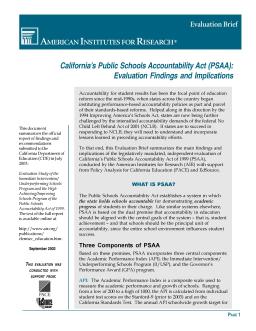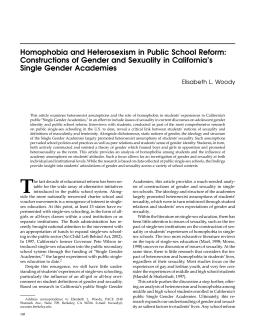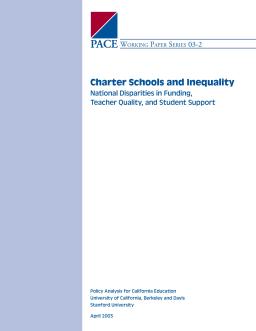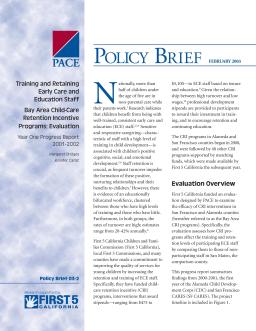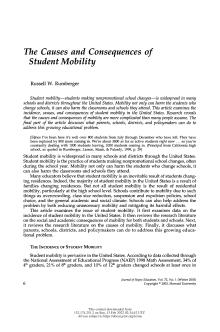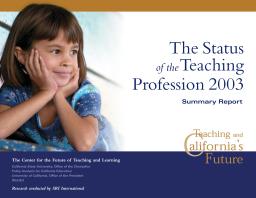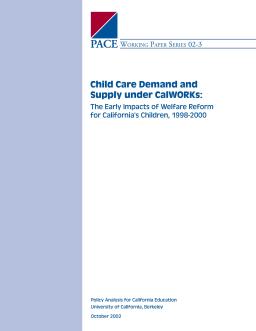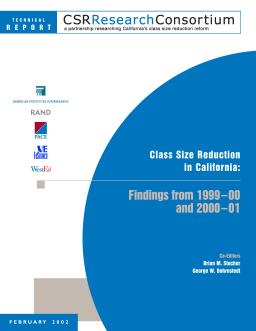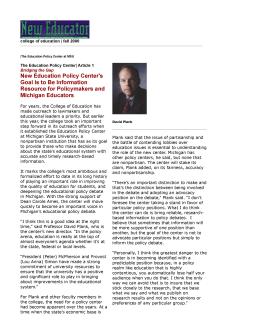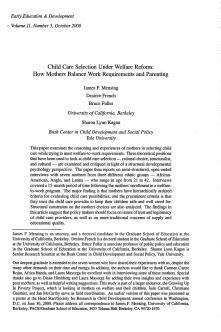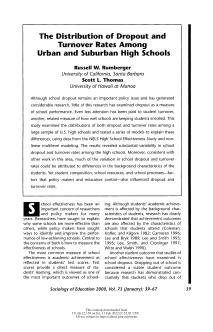Evaluation Findings and Implications
Published
Summary
This report evaluates California's Public Schools Accountability Act of 1999, which aimed to hold schools accountable for student results. The brief summarizes the main findings and implications of the legislatively mandated, independent evaluation of the Act, with the aim of helping states understand and learn from preceding accountability efforts.
Constructions of Gender and Sexuality in California’s Single Gender Academies
Published
Summary
This article examines the impact of heterosexist assumptions and homophobia on students' experiences in California's public "Single Gender Academies." Interviews with students reveal a critical link between sexuality, masculinity, and femininity, and the ways in which assumptions about sexuality are embedded in school policies, practices, and peer relations. The article provides an analysis of homophobia among students and the influence of academy assumptions on students' attitudes towards gender and sexuality.
Published
Summary
The No Child Left Behind Act of 2001 mandates all states to demonstrate “adequate yearly progress” towards state proficiency goals. This report explores how to measure sustained improvement in California public schools, and how demographic and school-level variables relate to student achievement. Annual Academic Performance Index scores alone do not indicate sustained improvement, so it is recommended to consider student progress over a longer time frame and all known variables that impact it.
National Disparities in Funding, Teacher Quality, and Student Support
Published
Summary
Charter schools were intended to close the achievement gap and create tight-knit communities that motivate students and teachers. The assumption is that charter schools can avoid the disparities that public schools face. Recent data from the National Center for Educational Statistics (NCES) allows for comparison between charter and public schools. The survey data illuminates similarities and differences between the two types of schools.
Bay Area Childcare Retention Incentive Programs Evaluation—Year One Progress Report, 2001–02
Published
Summary
The First 5 California Children and Families Commission has funded the Childcare Retention Incentive (CRI) to improve the quality of early care and education (ECE) staff training and retention. An evaluation funded by First 5 California assesses the efficacy of CRI programs in San Francisco and Alameda counties. This report summarizes the preliminary findings from the first year of the Alameda Child Development Corps and San Francisco CARES programs, which examine whether CRI recipients are more likely to participate in training and be retained compared to non-participating ECE staff.
Year One Progress Report, 2001–2002
Published
Summary
This policy brief examines the effectiveness of childcare retention incentive (CRI) programs in selected California counties. It assesses program design, participant characteristics, training activities, and retention rates among early care and education staff. The study aims to identify the impact of CRI programs on the stability and training of the ECE workforce, which is critical for improving the quality of care for children.
Published
Summary
This paper examines the incidence, causes, and consequences of student mobility in the US. Mobility not only harms the students who change schools, but also the classrooms and schools they attend. The causes and consequences of mobility are more complicated than many people assume. The authors suggest ways for parents, schools, districts, and policymakers to address this growing educational problem.
Summary Report
Published
Summary
This report argues that the state of California needs to prioritize better education for all children with a sustained long-term investment of resources and leadership. Despite political upheaval and fiscal problems, there is a consensus for better education. The authors suggest that the issue requires a response as intense and sustained as the state's response to natural disasters, and calls for a system of teacher development to ensure all teachers have the necessary knowledge and skills to meet academic standards.
The Early Impacts of Welfare Reform for California's Children, 1998–2000
Published
Summary
This report examines the effects of welfare-to-work and childcare capacity building on the childcare system in California, prompted by changes in the childcare system and welfare reform. The study was requested by the California Department of Social Services, and this paper provides an overview of the findings.
Published
Summary
This report discusses the implementation and impact of class size reduction in California's K-3 classrooms. The initiative was prompted by concerns over falling standardized test scores in the mid-1990s. The report includes findings from a consortium of evaluators, including PACE, and provides policy recommendations and lessons learned.
Year 1—Qualitative Implementation Study
Published
Summary
This report provides guidance on implementing childcare retention initiatives based on Alameda County’s Child Development Corps program. PACE conducted focus groups with stakeholders to gather feedback on the planning and implementation process. The program saw increased commitment from providers to their profession and seeking training opportunities, but challenges remain with fitting permit requirements to family providers and relevance of courses.
Findings from 1999–2000 and 2000–01
Published
Summary
This report evaluates California's Class Size Reduction (CSR) program up to the 2000-01 school year, updating previous findings on teacher qualifications, curriculum, student achievement, and special populations. The report also discusses how districts and schools have allocated resources in support of CSR.
New Education Policies
Published
Summary
Senior slump is a phenomenon unique to American high schools, where students view senior year as a time for nonacademic pursuits. This report suggests curtailing senior slump to add valuable months to students' education at a critical point in their intellectual development. Policy directives are presented to help American high schools reclaim the senior year.
New Education Policy Center's Goal Is to Be Information Resource for Policymakers and Michigan Educators
Published
Summary
Michigan State University's College of Education has established the nonpartisan Education Policy Center to provide lawmakers and educational leaders with accurate, research-based information to improve the state's educational system. With the support of the university's resources, the center aims to play an important role in deepening the policy debate and bringing about improvements in the system. The center was established due to a lack of systematic communication between researchers and policymakers in Michigan.
How Mothers Balance Work Requirements and Parenting
Published
Summary
This paper examines how mothers select childcare to meet welfare-to-work requirements. Interviews with seven mothers from different ethnic groups show that trust in childcare providers to keep their children safe is the most important criterion. Structural constraints on their choices are also analyzed. The findings suggest that policymakers should focus on trust and legitimacy of childcare providers in addition to supply and educational quality.
Published
Summary
This paper examines high school dropout and turnover rates in the US and tests models to explain the differences using data from the NELS High School Effectiveness Study. Variability was found among high schools, with much of the variation attributed to differences in student characteristics, but factors such as school resources and processes also influenced rates. Dropout and turnover rates are measures of school performance that policymakers and educators can influence.
